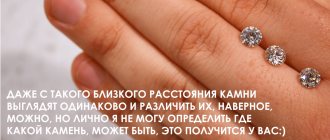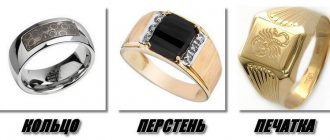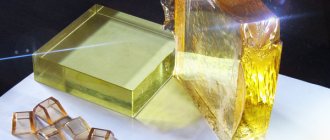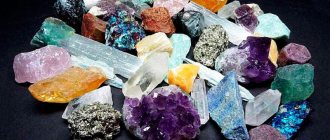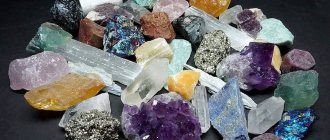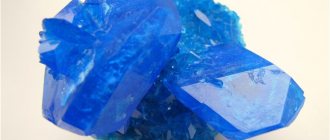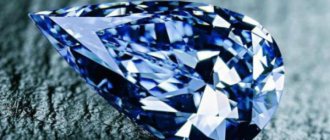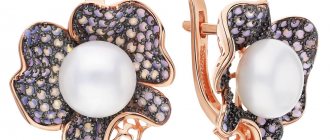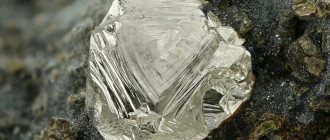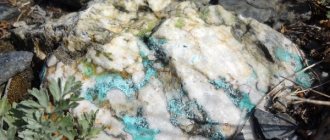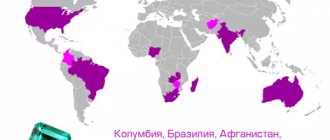Color varieties
Cubic zirconias are:
- colorless;
- colored.
The classic version is a colorless, transparent stone. Dyes are added to make it look like other precious gems. In this case, the colors of cubic zirconia are varied.
Table of main dyes:
| Element – dye | Color |
| Cerium | Red Yellow |
| Titanium | Brown |
| Chromium | Green |
| Aluminum, cobalt | Light blue, blue |
| Erbium | Pink |
Saturation depends on the mass of the dye. The larger the volume of the additional element, the deeper the color. Jewelers take advantage of the developments and create jewelry with artificial sapphires, garnets, amethysts, chrysolites, etc.
Carefully!
If you purchase a product at a low price and the sellers claim that it is a jewel, be wary! Most likely, this is a skillful fake.
Stone in the form of a talisman
An important property of fionite is its ability to accumulate energy. Thanks to this, it can be used to make various amulets.
The most common options include:
- horseshoe;
- Tibetan knot of happiness;
- 4-leaf clover;
- scooping spoon.
They also make many pagan amulets with cubic zirconia inserts. The use of crystals in them makes it possible to enhance the protective properties.
Cubic zirconia is a common gemstone that comes in a variety of shades and is very affordable. At the same time, it is important to know what kind of stone it is - fionite. The crystal is characterized by healing and magical properties. In order for the mineral to reveal its full potential, it is important to wear it correctly.
Production of cubic zirconia
Multi-colored cubic zirconia
In the production of semi-precious stones, Soviet manufacturing technology is used. At that time, scientists were not limited in the use of resources.
Now this method has many disadvantages in market conditions. Therefore, other countries are trying their best to simplify production, but in this case the gems are far from original.
Gems are obtained by high-frequency melting. The method consists of the following steps:
- The raw materials are loaded into the container.
- The high-frequency generator uses its energy to melt its contents.
- The water circulating in the pipes prevents the temperature from rising above 25 °C. Therefore, the surface of the stone remains cool.
- The melt is cooled.
- Crystals up to 2 cm in diameter are extracted from the core.
Production happens quite quickly. Gems grow up to 1 cm per hour.
The cheapest of them are colorless stones. Colored ones include various impurities, and accordingly their price is higher.
Synthetic gems are most often cut to look like diamonds. But cubic zirconia has more rounded edges and their number is usually less than 57.
Market of artificial jewelry stones
Currently, jewelry with synthetic stones is widely represented on the Russian and world markets. Artificial stones compare favorably with natural stones in price and often in quality. The volume of their production is constantly growing, and at the same time, synthesis technologies are being improved, which contributes to the appearance on the market of a wide variety of synthetic stones.
Among the synthetic stones presented on the market today, two main groups can be distinguished: the first includes stones that are complete analogues of natural stones, and the second includes artificial jewelry stones obtained in the laboratory and having no natural analogues (cubic zirconia, blue quartz, etc. ). Stones of the second group are usually used as imitations.
Synthetic stones represent a separate segment of the jewelry stone market. Some stones, after receiving them, take their place on the market, others gradually disappear, giving way to new ones. Changes in the market can be illustrated using the example of synthetic materials used to imitate diamond: in the late 40s. For these purposes, synthetic rutile was used, then in the mid-50s. its place was taken by strontium titanate, and later they began to use YAG (yttrium aluminum garnet) and GGG (gallium gadolinium garnet). After obtaining cubic zirconia (cubic zirconium oxide), all these materials were almost completely forced out of the market. At the end of the 90s. As an imitation of diamond, a new material has appeared on the market - synthetic moissanite (silicon carbide), but it is unlikely to replace cubic zirconia in the near future due to its high cost.
Today, jewelry with inserts of synthetic rubies, sapphires, emeralds, alexandrites , spinels, opals, and quartz of various colors is widely represented on the Russian market. A stone such as moissanite is relatively new and is not yet common. A synthetic diamond is a stone of exceptional rarity, much rarer than a natural one. Among synthetic stones that have no natural analogues, cubic zirconia of various colors are especially popular.
The price ratios between natural stones and their artificial counterparts vary greatly depending on the stone. For example, synthetic rubies can be 1000 times cheaper than natural ones , emeralds - 10 times, artificial amethysts are almost equal in price to natural ones, and synthetic diamonds can be more expensive than their natural counterparts.
Over the past decade, the main producers of synthetic stones in the world have been Russia, China, Japan and the USA. China is constantly improving synthesis technologies and increasing the production of synthetic stones, but there is no exact data on production volumes. However, China is known to be a supplier of hydrothermal emeralds, as well as some other synthetic stones, for the global market.
Our country has developed technologies for the synthesis of various jewelry stones. Synthetic stones produced in Russia are of high quality, there is a great demand for them abroad, therefore most Russian centers for the synthesis of mineral raw materials focus their production on foreign buyers, and, as a result, some stones, for example, synthetic diamonds, can be found on free sale only for abroad. Among synthetic diamonds produced in Russia, there are almost colorless and yellow varieties with various shades (brown, pink, orange, etc.). Cut yellow diamonds can weigh up to 2 carats, and the price of the gems per carat ranges from $40-50 (for brownish-yellow stones weighing less than 0.2 carats) to $3000 (for orange-pink and deep yellow diamonds weighing about 2 carats) .
Most people in our country believe that synthetic stone is no more than glass. This attitude is primarily due to the lack of available information: many people do not know that in laboratory conditions it is possible to obtain a stone that is a complete analogue of natural stone. On the contrary, abroad, this kind of information is more accessible, so people consciously go to buy synthetic stones, knowing what a synthetic stone is, whether it has a natural analogue, what advantages and disadvantages it has.
In connection with the development of modern synthesis methods, synthetic materials appear that are very similar in their properties to expensive natural stones, therefore, in order to avoid costly mistakes when purchasing, it is very important to determine the origin of the stone . When sold abroad, expensive natural stones (rubies, sapphires, emeralds) are accompanied by a gemological expert report , which indicates their origin. Inexpensive stones (for example, amethysts) are sold without expert opinions, so synthetic stones are often passed off as natural.
Often, standard gemological methods are not enough to identify the origin of a stone, so it becomes necessary to use more complex laboratory non-destructive methods. In this light, the role of gemological laboratories is increasing, where a complex of gemological and laboratory methods are used to identify jewelry stones. The ability of gemological laboratories to reliably determine the origin of a stone contributes to the stability of the price and demand for expensive natural stones.
The attitude towards synthetic jewelry stones in our country is currently, as a rule, negative. For many people, the word “synthetic” evokes negative emotions, and they do not consider purchasing a product with such a stone at all. Meanwhile, artificial stones can serve as a good alternative to expensive natural stones, since they have the same properties, but at the same time, an affordable price.
Ksenia Rosenberg, Maxim Viktorov Gemological Center of Moscow State University
Magical properties of cubic zirconia
Cubic zirconia ring
Despite its artificial origin, cubic zirconia has a special stone magic. He, like an empty vessel, is able to be filled with surrounding energy.
Buying cubic zirconia is not recommended for a person in a bad mood. Therefore, it is best to purchase jewelry with these minerals during a favorable period of life, full of positive events. Having been charged with positive energy, the owner of the stone will be able to get it back in order to get rid of sadness and increase his vitality.
It is not recommended to purchase cubic zirconia stones from resellers, since it is possible that the crystals have already absorbed someone else’s energy. However, to protect yourself, the stone can be cleansed of accumulated negativity in two ways: lower it into spring water or hold it over a fire.
The magical properties of the stone are suitable for creative individuals; such amulets can enhance creative thinking and awaken inspiration.
Astrologers are confident that amulets with this stone can save a person from possible dangers on the road and bring good luck and prosperity. These properties of crystals will benefit travelers, athletes and sailors.
Cubic zirconia is a symbol of happiness and success; it will be a wonderful gift for newlyweds, protecting the family from quarrels and giving peace of mind.
Talismans, amulets, amulets
Cubic zirconia
earrings Charms with artificial mineral are common, again due to availability. Keep in mind that the meaning of a talisman with a cubic zirconia stone depends primarily on the color.
- Blue is a symbol of creative people and promotes the discovery of talents.
- Black - suitable for business people. They are responsible for ingenuity, acumen, and prudence.
- Green will help an embittered person. This stone softens your temper. In addition, the amulet will be useful for those who want to feel unity with nature.
- The colorless stone is a symbol of honesty and openness. The mineral set in silver is a suitable talisman for innocent brides.
- The yellow look is suitable for unhappy people. It will absorb sorrows and help cope with life's disappointments.
- The blue mineral helps the owner achieve his goals.
- Charms with the pink variety are a suitable talisman for women. This gem is responsible for attractiveness, femininity, and personal happiness.
Artificial analogues bring success, help on a long journey and give the owner optimism.
Medicinal properties
Cubic zirconia has a dual nature - a natural base and a “diamond” structure, but an instant, by nature’s standards, creation process. Its medicinal and magical properties give rise to controversy.
Lithotherapists who are fans of the stone believe that it heals the body. From it comes the energy accumulated by the base substance plus received during creation.
Contemplation of the stone improves mood, giving strength to recover from a nervous shock, serious illness or surgery.
Who does the stone suit according to their zodiac sign?
Cubic zirconia is a stone that has an artificial nature. Therefore, astrologers did not assign it to a specific zodiac sign. At the same time, they recommend taking into account your horoscope when choosing the shade of the gem.
So, the elements are of great importance when choosing cubic zirconia:
- Fire - cubic zirconia saturates representatives of this element with energy. At the same time, red and pink crystals are suitable for Leo, purple and blue cubic zirconia for Sagittarius, and warm variations of yellow and green for Aries.
- Water - representatives of this element can use cubic zirconia as protection from troubles. Cancers should wear transparent or pale blue jewelry, and Scorpios should wear dark red ones. Blue and green cubic zirconia are suitable for Pisces.
- Air - cubic zirconia helps zodiac signs from this element to concentrate on details. This allows you to find a way out of any unpleasant situations. It is better for Aquarius to wear transparent or blue-blue stones, and for Gemini - purple, pink, lilac crystals. Blue and turquoise stones are suitable for Libra.
- Earth - cubic zirconia will help make representatives of this element less stubborn and irritable. Virgos should wear white, light green and lavender stones. Taurus has excellent compatibility with green, yellow and brown colors. At the same time, Capricorns should choose black, green and gray shades.
Black cubic zirconia is perfect for Capricorn.
For men
For Scorpio men, cubic zirconia will help get rid of negative energy and attract good luck. With the help of this crystal you will be able to improve your financial situation and strengthen family relationships.
For Libra men, the stone can be an excellent assistant in self-realization and love affairs. With its help, you can reveal your potential and show others your capabilities.
The stone is also ideal for Leos. Representatives of this sign have a very strong character. The mineral will help them improve relationships with loved ones, establish business relationships and conclude profitable deals.
Although cubic zirconia is an artificial stone, it is obtained on a natural basis. Therefore, many astrologers and esotericists recognize its healing and magical properties.
For women
Cubic zirconia will help Sagittarius women to reveal themselves in the professional sphere. It will help to show creativity and bring success in any endeavor. In addition, the stone will attract the attention of men. However, it should only be worn for special occasions.
For a Capricorn woman, this amulet will be an excellent choice. It will help you find a balance between your career and personal life. The gem will also allow you to gain financial independence and achieve your goals. For Virgos, the stone helps to attract a loved one.
A horseshoe with cubic zirconia will be a wonderful talisman.
Areas of application
Ring 925 silver, cubic zirconia Cubic
zirconia is often used in jewelry. Gold jewelry can be decorated with cubic zirconia inserts. They are also used to contrast the transparency or color of the main insert (the center of the composition), and as an imitation of diamonds.
In addition, they are used in dentistry, ceramic spraying, and the chemical industry.
How:
- in optics - in the manufacture of lenses for equipment;
- in dentistry - to create so-called dental ceramics;
- in medicine - part of medical scalpels.
History of the appearance of cubic zirconia
What is cubic zirconia? The crystals are of artificial origin and are grown from zirconium dioxide. Many people are interested in the question: is cubic zirconia a precious stone or not? This gem cannot be called precious. However, after processing, the crystal is difficult to distinguish from a diamond. They are similar not only in appearance, but also in physical characteristics. Other names of crystals also include jevalite, daimonsquay, and zirconite.
There are also natural minerals that have similar characteristics. Tazheranite is considered a natural analogue of the gem. It was found in the Baikal region and was named after the Tazheran Gorge.
The technology for manufacturing cubic zirconia is based on the use of modern equipment. Therefore, the stones are quite affordable. The most budget-friendly samples are translucent, transparent and colorless. Colored stones are considered more expensive.
The most complex technologies are used to imitate placer diamonds, which is why they will be the most expensive. The cost depends on the cut, production time, and number of grams.
So, what kind of stones are these - cubic zirconia? Essentially, these are transparent crystals that are of synthetic origin and contain zirconium dioxide. On the Mohs scale their hardness is 7.5-8.
Cubic zirconias are characterized by a variety of colors.
The unique properties of minerals make it competitive, despite its artificial origin.
So, crystals are characterized by the following features:
- cubic crystal lattice;
- high strength coefficient parameters;
- optimal refractoriness parameters;
- resistance to chemicals;
- the ability to refract light.
The shades of minerals are very different - blue, pink, black, blue. The specific color is determined by the impurities in the composition. To obtain green stones, chromium is used, pink ones - erbium, red - neodymium. At the same time, copper gives the crystals a yellow color, and titanium gives them a golden brown color.
Scientists even managed to achieve a unique lavender shade of gems. It has no analogues in nature.
Growing cubic zirconia is considered a rather complex and labor-intensive process. However, the stones are still more affordable than expensive natural minerals - diamonds and sapphires.
The use of gems is not limited to jewelry making. Such crystals are used in optics. They are also used in the chemical industry. Stones can withstand temperatures greater than 2500 degrees. Thanks to this, they can be used in the most difficult conditions.
Crystals are used to make glass cutters and medical scalpels. They are also used in dentistry for ceramic spraying.
It is impossible to obtain at home
Products and decorations
Gold ring with cubic zirconia.
Availability and a wide range of colors have ensured cubic zirconia's high popularity in jewelry. Artificial stone is found in products made of silver, gold, and platinum.
It can favorably set off the central gem in a carmesine frame or even sit next to a diamond - however, the latter combination is considered unethical.
However, cubic zirconia allows you to create jewelry of high artistic value, comparable to works of art.
This is an excellent educational material for novice jewelers, which is easy to purchase at hardware stores. The synthetic analogue gives everyone the opportunity to buy bold, stylish, unusual products or restore their favorite jewelry for a low fee.
How to choose and buy jewelry with cubic zirconia?
Sometimes it can be difficult to understand the variety of products with cubic zirconia. But so that you don’t get tired of the decoration quickly, approach your choice responsibly.
Based on your taste preferences and clothing style. Synthetic material can be any color. You can easily choose a product to match the color of your eyes or dress. The classic transparent color goes with everything and shimmers brightly in the sun.
Large stones are not always comfortable for daily wear. For frequent use, it is recommended to give preference to smaller and more comfortable sizes.
Rules of care
Products with cubic zirconia are not as demanding to care for as many precious stones. For cleaning, you can use the following algorithm:
- Stir liquid soap in warm water until foam forms. Aggressive soap products should not be used.
- Use the resulting solution to clean the stone using a soft toothbrush or other similar device.
- We thoroughly rinse the cubic zirconia under running water.
- Wipe dry with a soft cloth. Cotton works great.
When cleaning, consider other materials that are near the crystal. Gold and silver require their own care. Natural stones can also be placed on the decoration. They may not be suitable for this kind of care and should be careful.
How much does cubic zirconia cost?
Jewelry brands and workshops purchase crystals in bulk. A package of one hundred medium-sized stones costs $10–15 (the price of an average quality diamond is up to $5 thousand per carat).
The cost of cubic zirconia in the shades “ruby”, “sapphire”, “blue topaz” is twice as expensive as the standard ones. A good quality stone of 1.95 carats, 7x5 mm, is valued at $5, that is, the price per gram is about $12.
The price of products is determined by the precious setting, not the stone.
Gold ring with cubic zirconia
Gold (585th standard):
- engagement ring with cubic zirconia - up to $100–120;
- stud earrings – $45–75, dangling earrings – $220–350;
- pendant - from $20.
Silver (925 standard):
- ring – $25–75;
- pendant earrings – $150;
- pendant - from 10 $.
How to distinguish a diamond from cubic zirconia?
Cubic zirconia is a fairly hard stone (8 on the Mohs scale; a diamond is 10), its density and dispersion are also close to those of a diamond, which ensures an incredible visual similarity between the two minerals. However, it will not be difficult for a professional to distinguish them. You can try this too:
- Test “in the light”: cubic zirconia will allow sunlight to pass through it “unhindered”, and inside the diamond it will be in the form of a luminous point.
- Checking the density: if you put two stones side by side, it will be noticeable that the edges of the diamond and cubic zirconia are different - the first will have sharper edges.
- Breath test: Breathe on a pebble. Fogged up? In front of you is cubic zirconia.
- Thermal test: the diamond will not heat up from the warmth of your hands and heat.
How to care for stone
Earrings with cubic zirconia
This may seem strange, but jewelry owners do not always know how to properly care for them. Often jewelry lovers do not follow even the most basic care rules. This leads to fading and darkening of the jewelry.
What you need to know:
- Cubic zirconia does not like strong chemicals. And perfume, by the way, too. Spray them before you put on your jewelry.
- A beautiful, almost diamond-like, artificial stone does not have its strength, and therefore is very afraid of impacts and falls.
- Like natural stones, these crystals lose their luster. Cleaning cubic zirconia at home is not difficult - all you need is a soap solution and a cloth.
If you don’t have a suitable (not harsh) soap, you can clean it with alcohol. Just take it not in its pure form. Dilute 1:5 with water. Then immerse the stone in the liquid and leave it for several hours. Remove dirt with a brush.
encyclopedia "stones"
All types of natural stone play a different, but important, meaning in the life of each of us. By visiting our online portal, you can find out comprehensive information about all kinds of this natural material, which is used both in construction and creating jewelry, and for the purpose of healing the human body. All material on the site is divided into subcategories, which makes it more convenient to use.
Main headings
The following sections are presented to the attention of people interested in different types of stones, their properties, meaning and application features:
- Basalts. By visiting this section of our website, you will learn what the materials belonging to this effusive rock are, and also become familiar with the features of their use in construction. Based on basalts, building materials such as basalt wool and basalt cardboard are made, which perform thermal insulation functions. This section will also allow you to get acquainted with the best manufacturers of basalt fiber.
- Volcanic stones. The properties and applications of syenite, peridotite, labradorite, andesite, aplite, liparite, granodiorite and other volcanic rocks are all described in detail in this section of our website.
- Granite. Everyone has probably heard about such a stone as granite, because it is the most common rock. However, not everyone is familiar with the peculiarities of origin, production, varieties and all the subtleties of using granite. If you visit this section, you will also gain useful information about the technology of wall cladding with granite.
- Precious. Stones belonging to this category of natural materials attract many women. By visiting this section, you will receive a comprehensive answer to questions about such precious stones as diamonds, tourmaline, Paraiba, verdelite, opal, topaz, zircon, alexandrite and others, mainly used in jewelry.
- Quartzites. Are you interested in questions about how quartzite is mined and processed, what the material is and what types of it exist? This means that the information presented in this section of our website will be useful to you.
- Corals. Coral is a noble stone that comes in many varieties in nature. Here you will receive comprehensive information about this natural material, used both in construction and in jewelry.
- Landscape stone. In landscape design, in the process of landscaping home gardens and park areas, a large number of different types of natural stone are used. This category consists of rocks such as decorative sandstone and limestone, boulder, cobblestone, goldstone and other stones. In addition to information about these rocks, this section describes possible options for landscape work using these types of stones.
- Mineral stones. Almost all minerals are widely used in the life of modern man. These are such well-known stones as amber, azurite, adularia, aventurine, zircon and many others, which are distinguished by their unique properties, allowing the use of materials in construction, jewelry and medicine.
- Marble. Marble products have always been considered the standard of luxury and wealth. If you are interested in the properties, as well as features of the use and processing of this stone, visit this section of our website.
- Facing stones. Don’t know yet what kind of stone is best to line a stove in a private house or how to use shell rock for construction and facing work? Study the material presented in the “Facing stones” section, which also contains information about the possible types of this material for cladding, its properties and application features.
- Finishing. Which stone is best for finishing, which natural stones are used in interior design in different styles - these are questions that often concern novice builders. Visit the “Finishing Stones” section, here you will find comprehensive answers to these and many other questions. In addition, get acquainted in detail with the features and properties of such natural finishing materials as dolomite, limestone, shungite, sandstone, slate and some others.
- Ornamental stones. When creating magnificent jewelry and interior items, such types of ornamental stones as amber, lapis lazuli, malachite, jasper, heliotrope, charoite, jadeite, hematite, agate, and onyx are widely used. You will learn about the properties and features of using these stones in creating many crafts in this interesting section.
The “Articles” section makes it possible to find out a lot of educational information about how various types of natural stones are processed and used, as well as about their properties and even the effect on the human body. All this and much more about this type of material, such as natural stones, is described in as much detail as possible on our website.
On this topic
Natural facing stone for finishing residential premises.
Compatibility with other stones
A laboratory-grown crystal can be combined with any natural stones.
From a decorative point of view, the most versatile is colorless cubic zirconia - it sits well alongside transparent topazes, amethysts, citrines, and garnets. Surrounded by small cubic zirconias, each of these stones will shine brighter.
The proximity to cubic zirconia also enhances the energetic impact of natural minerals. Any piece of jewelry that combines a precious stone and an artificial one will be a powerful talisman. It must be worn with caution.
How is cubic zirconia deciphered?
What is cubic zirconia? These are artificial crystals that were obtained by scientists from the Physical Institute of the Academy of Sciences. This happened in 1968. The decoding of the name corresponds to the first letters of the FIAN institution where they were invented.
Initially, cubic zirconias were intended for use as a laser element. Scientists set themselves the task of creating a stone with certain optical characteristics and without defects that are inherent in natural materials. Then the gems began to be used in the jewelry industry.
